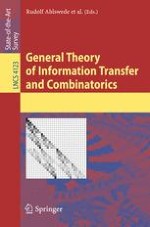2006 | Buch
General Theory of Information Transfer and Combinatorics
herausgegeben von: Rudolf Ahlswede, Lars Bäumer, Ning Cai, Harout Aydinian, Vladimir Blinovsky, Christian Deppe, Haik Mashurian
Verlag: Springer Berlin Heidelberg
Buchreihe : Lecture Notes in Computer Science
